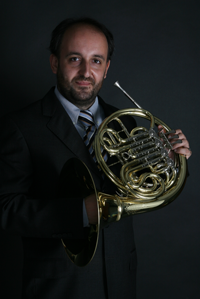Dur: Ca. 7'15''
Published in January 2022 by Arpejo Editora
Also available at: June Emerson
The horn repertoire, especially the one written for younger players differs from the repertoire written for advanced and professional students. More than ever it is important that it results in an idiomatic way by taking advantage of the characteristics of the instrument in order to achieve maximum effect with minimal effort. This is an area that has always interested me and that has, moreover, been the subject of my doctoral research. In the challenge, which was launched to me by Arpejo Editora, I was asked to compose a set of 5 pieces for a horn and piano with increasing difficulty and that somehow had to be related to the Portuguese popular songbook. From the compositional point of view it was something very attractive given that a good part of the songbook is documented, but at the same time it was a challenge since much of this songbook relies on repetitive rhythmic and melodic elements that gain another dimension with the lyrics. Quite possibly, the songs chosen are unknown to the younger ones, who have lately tended to adopt the songbook from other countries. This is intended to make a small contribution to reversing this trend.
“Maragato Son” (50'') is a traditional song of Trás-os-Montes and Alto Douro (Paradela/Miranda do Douro). If it is played in a horn in F, the horn player will only need to move the first finger. (PLAY ALONG)
“Era ainda pequenina” [I was sill young] (1') is a song from the Beiras (Monsanto). In this version, optional fermatas and ornaments have been added but they can be omitted or even improvised. When playing it for the second time, it should be performed without any ornaments or fermatas. (PLAY ALONG)
From Trás-os-Montes and Alto Douro: “Olha o velho, Olha o velho” [look at the old man, look at the old man] (1'35'') is a small satirical song that repeats itself with different lyrics. In this instrumental version, more sections were added with musical material that, when performed on the B flat side of the horn can be played only by moving the second finger. (PLAY ALONG)
“Ó malhão, triste malhão” [sad malhão] (1'25'') is a song from the Beiras (Mira). The fingerings tremolo at the beginning of the horn part takes advantage of the fact that the indicated notes can be played with the same fingering on either the F side or on the B flat side of the horn. Therefore, to perform this tremolo it is only necessary to move your thumb. (PLAY ALONG)
Finally, “Vai-te embora, papão” [Go away, bogeyman] (2'25'') is a lullaby from the Beiras region. The theme is initially presented by the horn, while the piano performs strange sounds... could it be the bogeyman? Just like a monster that doesn't let the baby sleep, the theme gradually gains intensity until it finally calms down and fulfils the goal of the lullaby. This theme has the particularity of having time signature changes that may initially seem like a bogeyman, but that with practice will become easier. (PLAY ALONG)
Playalong available here



